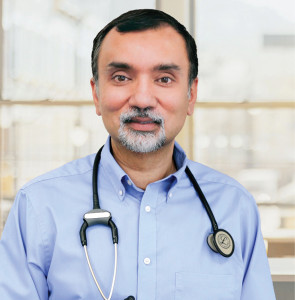“Ontario’s doctors are concerned about the serious implications of operational changes to public health units”
OMA’s president, Dr. Sohail Gandhi
Dr. Sohail Gandhi has begun in May his one-year term as President of the Ontario Medical Association (OMA), and will continue to serve as Director of the OMA’s Section of General and Family Practice.

Gandhi has practiced rural Family Practice in Stayner, Ontario since 1992 and continues to hold hospital privileges at the Collingwood General and Marine Hospital. A graduate of the University of Toronto. Dr. Gandhi is currently an assistant clinical professor at Queen’s University Medical School and a lecturer in medicine at the University of Toronto.
Dr. Gandhi has been awarded the Queen Elizabeth II Diamond Jubilee Medal for Dedicated Service to Peers and the Community, and the Award of Excellence from the Ontario College of Family Physicians.
President of OMA spoke this week with Milénio Stadium, and he admits that Ontario doctors are worried with the health cuts in the province.
Milénio Stadium: Ontario Premier Doug Ford is preparing to reduce the number of health units in Ontario from 35 to 10 to tackle the provincial deficit. Do we have reasons to be worried?
OMA: The OMA believes that public health is a key component of Ontario’s health system. The foundational purpose for public health is to promote and protect health, and prevent disease and injury through the delivery of highly valued programs and services, ranging from vaccination, prenatal and parenting classes, to water safety programs and making sure our restaurants provide safe places to eat. The true proof of the value of public health is the absence of negative health outcomes or harmful health behaviours and so, the paradox of public health is that when it works, the benefits are largely invisible. Counting the number of children contracting measles is easy; counting those who didn’t get measles because they were vaccinated is more difficult, but may be more valuable.
Public health complements and supports primary care, and without an effective and proactive public health system, more people will get sick and hallway medicine, wait times and cost to the system will increase.
Ontario’s doctors are concerned about the serious implications of operational changes to public health units. At this time of system change, the OMA has called for Ontario to maintain a strong leadership team of expertly qualified and properly credentialed public health physicians that is sufficient to support and lead the province’s public health system, and for the Government of Ontario to maintain core public health programs as the public health system is transformed.
Ontario’s doctors urge the Ontario government to work with stakeholders, including the Medical Officers of Health and other physicians in each community, to ensure that patients do not suffer due to reduction of core public health programs and services.
Milénio Stadium: Do we have enough doctors in Ontario?
OMA: No, we don’t have enough doctors in Ontario. In 2018, Ontario had 2.3 physicians for every 1,000 people, and ranked 7th out of ten provinces in the ratio of physicians to population (Newfoundland and Labrador has the highest ratio at 2.7 per 1,000 people, and PEI has the lowest with 1.97 per 1,000 people). Meanwhile, Ontario’s population is growing, ageing, and becoming more complex. This means there will be even more demands for patient care.
By contrast, the average number of physicians in the European Union in 2015 was 3.6 per 1,000 population. Sweden, for example, reported 5.4 physicians per 1,000 people in 2016, while Portugal had 3.3 physicians per 1,000 people in 2016.
Milénio Stadium: What are the medical specialties most sought after by patients?
OMA: The specialties with the most active physicians identified from OHIP fee-for-service claims are: Psychiatry, Internal Medicine, Anesthesiology, Pediatrics, Diagnostic Radiology.
Milénio Stadium: Ministry of Health doesn’t support anymore Telemedicine. Do you believe that direct contact between doctor and patient is a priority?
OMA: The Ministry of Health does support virtual care. The OMA is also supportive of virtual care and has been engaging in discussions with the Ministry on the expansion of virtual care in Ontario.
The Ontario Telemedicine Network (OTN) is one of the largest telemedicine networks in the world. It uses two-way videoconferencing to provide access to care for patients in every hospital and hundreds of other health care locations across the province. The province pays for these visits through a Ministry of Health (MOH) telemedicine budget, which is separate from OHIP. A Home Video Visit pilot project to expand virtual care by allowing physicians to conduct video visits with patients using their own devices in any appropriate location through a secure OTN link (OTNinvite) has been underway since 2014. For further questions about this pilot project and OTN generally, we would refer you to the network or the Ministry of Health.
Virtual care can supplement in-person care for many patients, especially if they have mobility issues and can’t easily leave the house, or if they need to travel long distances to get to their doctors’ clinics. A virtual visit may be appropriate for such things as discussing test results, regular follow-ups for patients with chronic disease, and managing common health problems such as cold and flu.
Of course, whether or not a physician has a virtual appointment with a patient or needs to speak to or examine the patient in-person completely depends on the physician’s professional judgement of what is clinically appropriate for the specific individual patient.
Milénio Stadium: When it’s the best time to get a flu vaccine and why is so important to take it?
OMA: The ideal time to get the flu shot is in the last three weeks of November. That’s because it takes the flu shot three to four weeks to kick in. The flu shot wears off after a period of time so you want to time peak immunity to when flu season peaks in February.
Everyone should get the flu shot to protect themselves and others. The flu vaccine is safe for children 6 months and older.
Historically, only about a third of people get the flu shot, which means the illness can spread more easily. The flu also hits emergency rooms hard in February, so getting the flu shot will help ease emergency room wait times.
Milénio Stadium: Ministry of Health is banning the promotion of vapour products in convenience stores and gas stations. Why is important to stop this kind of advertising?
OMA: According to the most recent Canadian Tobacco, Alcohol and Drugs Survey, 23 percent of students in grades 7-12 have tried a vaping product. Many vaping devices contain nicotine and there is a lack of awareness and understanding among youth about the addictive nature of nicotine, as well as the potential negative health effects of nicotine exposure. There is evidence that youth who use vaping devices are more likely to smoke tobacco later in life. The need to protect youth from accessing and using vaping devices and products is paramount.
Joana Leal/MS








Redes Sociais - Comentários